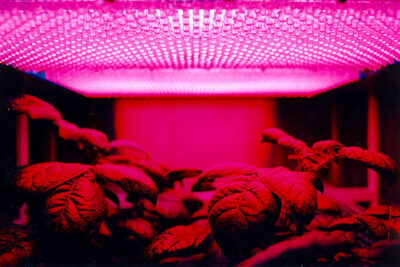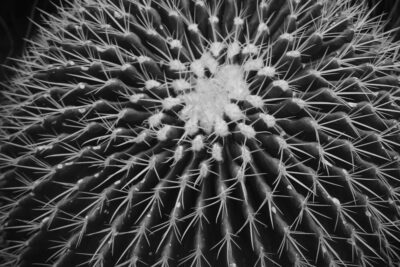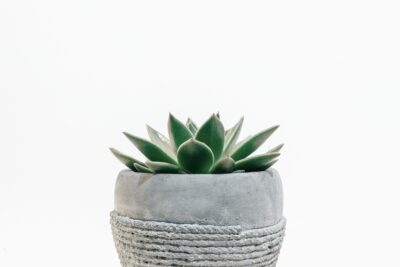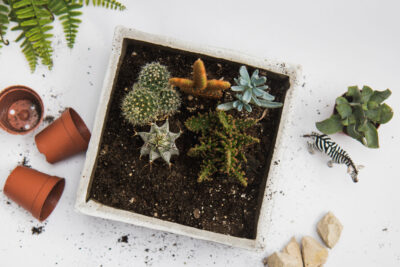
Managing Sun Stress: How Succulents Cope with Excessive Sun Exposure

Succulents are a diverse group of plants known for their ability to store water in their leaves, stems, and roots. They are highly adapted to arid environments and are often found in desert regions around the world. One of the challenges succulents face in these harsh environments is excessive sun exposure, which can lead to sun stress. Understanding how succulents cope with and manage this stress is crucial for their survival and successful cultivation.
We will explore the various strategies that succulents employ to cope with excessive sun exposure and the physiological and morphological adaptations that enable them to thrive in intense sunlight. We will discuss the importance of water storage, the role of specialized leaf structures, and the mechanisms that allow succulents to regulate their water loss and temperature. Additionally, we will highlight some practical tips for managing sun stress in cultivated succulents, including proper placement, watering techniques, and providing adequate shade. By understanding how succulents have evolved to deal with excessive sun exposure, we can better care for these unique plants and create optimal growing conditions for them.
- Succulents have thick, fleshy leaves that store water, allowing them to withstand extended periods of sun exposure
- Succulents have a waxy coating on their leaves that helps to reduce water loss and protect them from sun damage
- Succulents have specialized tissues that enable them to efficiently absorb and store water, helping them survive in arid conditions
- Succulents have shallow root systems that spread out wide, allowing them to quickly absorb rainwater and maximize water intake
- Succulents have the ability to go into a dormant state during extended periods of sun exposure, conserving energy and water
- Succulents can adapt to excessive sun exposure by developing thicker and more compact growth habits, reducing surface area exposed to the sun
- Succulents can tolerate high temperatures by closing their stomata (pores on their leaves) to prevent water loss through transpiration
- Succulents can change the orientation of their leaves or stems to minimize direct sun exposure and reduce the risk of sunburn
- Succulents can produce pigments such as anthocyanins to protect themselves from harmful UV radiation
- Succulents can grow in shaded areas or under the protection of larger plants to avoid excessive sun exposure
- Frequently Asked Questions
Succulents have thick, fleshy leaves that store water, allowing them to withstand extended periods of sun exposure
Succulents are known for their unique ability to thrive in arid and sunny environments. Their thick, fleshy leaves act as natural reservoirs, storing water for times when it is scarce. This adaptation enables succulents to endure extended periods of sun exposure without experiencing significant damage or stress.
When succulents are exposed to excessive sunlight, they activate a series of mechanisms to cope with the stress. One of the main strategies is the production of specialized pigments called anthocyanins, which give their leaves a reddish or purple hue. These pigments act as natural sunscreens, protecting the plant's tissues from harmful UV radiation.
In addition to their unique pigmentation, succulents have evolved other physical adaptations to manage sun stress. Some species have a waxy or hairy coating on their leaves, known as epicuticular wax or trichomes, respectively. These structures help to reduce water loss through evaporation and provide an extra layer of protection against intense sunlight.
Strategies for managing sun stress in succulents:
- Water storage: Succulents store water in their leaves, stems, or roots, allowing them to survive in dry environments and endure prolonged sun exposure.
- Anthocyanin production: The production of anthocyanins helps to shield succulents from harmful UV radiation, reducing the risk of sunburn and tissue damage.
- Epicuticular wax and trichomes: The presence of a waxy or hairy coating on the surface of leaves helps to minimize water loss and provides an additional barrier against excessive sunlight.
- Reduced leaf surface area: Some succulents have evolved to have smaller or more compact leaves, reducing their overall surface area. This adaptation helps to limit water loss and decrease the risk of sun damage.
- Camouflage: Certain succulents have developed mechanisms to blend in with their surroundings, such as adopting a gray or green coloration, which helps to reflect sunlight and reduce heat absorption.
Overall, succulents have evolved a variety of strategies to cope with excessive sun exposure. Their ability to store water, produce protective pigments, and develop physical adaptations allows them to thrive in sun-drenched environments where other plants might struggle. By understanding these unique coping mechanisms, we can better appreciate and care for these resilient and beautiful plants.
 Can Succulents Thrive in Outdoor Summer Conditions?
Can Succulents Thrive in Outdoor Summer Conditions?Succulents have a waxy coating on their leaves that helps to reduce water loss and protect them from sun damage
One of the most fascinating aspects of succulents is their remarkable ability to cope with excessive sun exposure. These plants have evolved unique adaptations that allow them to thrive in arid and sunny environments. One such adaptation is the presence of a waxy coating, known as the cuticle, on their leaves.
This waxy cuticle serves as a protective barrier, reducing the amount of water lost through transpiration. Transpiration is the process by which plants release water vapor into the atmosphere. In hot and dry conditions, this can be detrimental to plant survival. However, succulents have developed a thick layer of wax on their leaves, which acts as a shield against excessive water loss.
Additionally, the waxy cuticle has another important function: it helps protect succulents from sun damage. The intense rays of the sun can be harmful to plant cells, leading to a condition known as sunburn. Just like humans, plants can also suffer from sunburn when exposed to prolonged periods of intense sunlight.
However, succulents have evolved to combat this issue. The waxy coating on their leaves acts as a natural sunscreen, shielding the plant's cells from harmful ultraviolet (UV) radiation. This adaptation enables succulents to thrive even in the harshest of environments, where other plants would struggle to survive.
Furthermore, the waxy cuticle also plays a role in reflecting sunlight. The wax reflects a portion of the sun's rays, preventing them from penetrating deep into the leaf tissues. This reflection helps to keep the plant's temperature lower, reducing the risk of overheating.
In addition to their waxy cuticle, succulents have another mechanism to cope with excessive sun exposure: their unique leaf structure. Unlike the broad and thin leaves of many other plants, succulents typically have thick and fleshy leaves. This structural adaptation allows them to store large amounts of water, which they can utilize during times of drought or intense heat.
 Succulent Flowering Times: When Do They Bloom?
Succulent Flowering Times: When Do They Bloom?The thick leaves of succulents act as reservoirs, storing water for extended periods. This water storage capacity enables them to withstand long periods without rainfall or in extreme heat conditions. By storing water in their leaves, succulents have a readily available resource to sustain themselves during times of stress.
The waxy cuticle and unique leaf structure of succulents are crucial adaptations that help them cope with excessive sun exposure. These plants have developed remarkable strategies to reduce water loss, protect against sun damage, and store water effectively. These adaptations allow succulents to thrive in environments where other plants struggle, making them a popular choice for gardens and indoor spaces.
Succulents have specialized tissues that enable them to efficiently absorb and store water, helping them survive in arid conditions
Succulents are a diverse group of plants known for their ability to thrive in dry and arid environments. One of the key features that sets succulents apart from other plants is their specialized tissues, which allow them to efficiently absorb and store water. These adaptations make succulents well-equipped to cope with excessive sun exposure and the stresses that come with it.
One of the main adaptations that succulents have is their thick, fleshy leaves and stems. These structures are filled with water-storing tissues, such as parenchyma cells and water-holding vacuoles. The thickened leaves and stems act as reservoirs, allowing succulents to store water for extended periods of time. This water storage capacity enables succulents to survive in arid environments where water is scarce and unpredictable.
Furthermore, succulents have a unique ability to absorb water through their specialized root systems. Many succulents have shallow, wide-spreading roots that allow them to quickly capture water when it becomes available, such as during rainfall or dew formation. In addition, some succulents have developed specialized root structures, such as adventitious roots or aerial roots, which help them absorb moisture directly from the air.
In order to protect themselves from excessive sun exposure, many succulents have evolved adaptations like spines, hairs, or waxy coatings on their leaves. These physical features serve as a form of sunblock, reducing the amount of direct sunlight that reaches the plant's tissues. By minimizing sun exposure, succulents are able to prevent excessive water loss through evaporation, which can be detrimental in arid environments.
Another fascinating adaptation of succulents is their ability to undergo temporary dormancy periods during extreme sunlight and heat. When faced with prolonged periods of intense sun and high temperatures, some succulents enter a state of dormancy, in which they slow down their metabolic processes and conserve energy. This dormancy allows succulents to withstand harsh conditions and survive until more favorable environmental conditions return.
 Unlocking the Secrets: Expert Tips for Growing Large Succulents
Unlocking the Secrets: Expert Tips for Growing Large SucculentsSucculents have evolved a range of specialized adaptations that enable them to cope with excessive sun exposure and thrive in arid environments. Their water-storing tissues, unique root systems, protective physical features, and temporary dormancy periods all contribute to their ability to withstand sun stress. Incorporating succulents into your garden or indoor space can not only add beauty but also serve as a reminder of the incredible resilience and adaptability of nature.
Succulents have shallow root systems that spread out wide, allowing them to quickly absorb rainwater and maximize water intake
Succulents are well-known for their ability to thrive in arid environments, thanks to their unique adaptation to excessive sun exposure. One of the key ways succulents cope with this stress is through their shallow root systems.
The shallow root systems of succulents spread out wide, allowing them to quickly absorb rainwater and maximize water intake. This adaptation is crucial in arid regions where rain may be sporadic and infrequent. By having shallow roots, succulents can efficiently capture any available moisture, ensuring their survival even in harsh conditions.
Furthermore, the wide distribution of their roots helps succulents anchor themselves firmly in the ground, preventing them from being easily uprooted by strong winds or heavy rains. This stability is essential for their overall well-being and growth.
Another interesting aspect of succulents' shallow root systems is their ability to access surface-level moisture. While most plants rely on deep soil moisture, succulents can absorb water from the surface, including morning dew or light rainfall. This unique adaptation allows them to make the most of any moisture available, further enhancing their resilience to sun stress.
Moreover, succulents have evolved to store water in their leaves, stems, or roots, depending on the species. This adaptation helps them survive prolonged periods of drought and excessive sun exposure. The water-storing capability of succulents allows them to endure extended periods without rainfall, relying on the stored water to sustain their growth and metabolism.
 Encouraging Long Stems and Flowers in Succulents
Encouraging Long Stems and Flowers in SucculentsSucculents have developed various mechanisms to cope with excessive sun exposure and thrive in arid environments. Their shallow root systems enable them to efficiently absorb water, while their ability to store water helps them endure long periods without rainfall. These remarkable adaptations make succulents a fantastic choice for both indoor and outdoor gardens, as they can add beauty and greenery even in the harshest of conditions.
Succulents have the ability to go into a dormant state during extended periods of sun exposure, conserving energy and water
Succulents, with their thick, fleshy leaves and stems, have developed some remarkable adaptations to survive and thrive in arid environments. One of their most impressive abilities is their capacity to cope with excessive sun exposure. When faced with intense sunlight, succulents have a unique strategy - they go into a dormant state.
Dormancy is a survival mechanism employed by many plants during unfavorable conditions, such as extreme heat or drought. Succulents, however, have mastered the art of dormancy as a response to excessive sun exposure. When the sun's rays become too intense, succulents slow down their metabolic processes and enter a state of rest. This period of dormancy allows them to conserve precious resources, including energy and water.
During dormancy, succulents reduce their transpiration rate, which is the process by which plants release water vapor through their leaves. By minimizing water loss, succulents can retain moisture within their cells for longer periods, ensuring their survival even in harsh sun-drenched environments.
Additionally, succulents have evolved to store water in their specialized tissues. Their thick leaves and stems act as reservoirs, allowing them to store water for extended periods. This adaptation enables succulents to withstand prolonged periods of sun exposure without experiencing water stress.
Furthermore, succulents have a unique defense mechanism against sun stress - the production of pigments. Many succulents develop vibrant colors, such as red, purple, or blue, which are not only aesthetically pleasing but also serve a functional purpose. These pigments, known as anthocyanins, act as a natural sunscreen, protecting the succulent's cells from harmful ultraviolet (UV) radiation. By absorbing UV rays, the pigments shield the plant's vital tissues, preventing damage and ensuring its survival.
 Can Succulents Thrive in Full Sunlight Without Suffering Damage?
Can Succulents Thrive in Full Sunlight Without Suffering Damage?Succulents have evolved remarkable strategies to cope with excessive sun exposure. Their ability to go into a dormant state, coupled with their water-storing capacity and the production of protective pigments, enables them to endure and thrive under intense sunlight. So, if you're thinking of adding some greenery to your sun-drenched garden or want to care for indoor succulents near a sunny window, rest assured that these resilient plants have what it takes to manage sun stress.
Succulents can adapt to excessive sun exposure by developing thicker and more compact growth habits, reducing surface area exposed to the sun
Excessive sun exposure can be detrimental to many plants, but succulents have developed unique strategies to cope with this challenge. These resilient plants are known for their ability to thrive in arid conditions, making them perfect candidates for areas with intense sunlight.
One of the ways succulents manage sun stress is by developing thicker and more compact growth habits. Their leaves and stems often have a waxy or powdery coating, which helps to reduce water loss through evaporation. This adaptation also acts as a natural sunscreen, shielding the plant's tissues from harmful UV rays.
In addition to their physical defenses, succulents also minimize the surface area exposed to the sun. Unlike other plants that have broad leaves, succulents typically have small, thick leaves or even spines. These reduced leaf surfaces help to decrease the overall water loss and limit sun damage.
Furthermore, succulents possess the ability to store water in their fleshy leaves, stems, or roots. This water reservoir allows them to withstand prolonged periods of drought and endure high temperatures. By storing water, succulents can survive in environments where other plants would wither under the scorching sun.
Diverse Succulent Strategies
The succulent family encompasses a wide range of plant species, each with its unique way of coping with excessive sun exposure. Some succulents, like the Aloe vera, have developed a gel-like substance within their leaves, which not only provides additional moisture but also acts as a protective barrier against sunburn.
 Cold Hardy Succulents: Flourishing in Chilly Climates
Cold Hardy Succulents: Flourishing in Chilly ClimatesOther succulents, such as the Echeveria, have rosette-shaped growth habits that allow them to form a natural canopy. This arrangement creates shade for the lower leaves, shielding them from direct sunlight. By clustering their leaves in a circular pattern, these succulents effectively reduce sun stress on their delicate foliage.
Succulents have evolved various mechanisms to cope with excessive sun exposure. Their ability to develop thicker growth habits, reduce surface area exposed to the sun, and store water in their tissues enables them to thrive in harsh environments with intense sunlight. By understanding and appreciating these unique adaptations, we can better manage and care for these fascinating plants.
Succulents can tolerate high temperatures by closing their stomata (pores on their leaves) to prevent water loss through transpiration
Succulents are known for their ability to thrive in hot and arid climates. One of the ways they manage to withstand excessive sun exposure and high temperatures is by closing their stomata. Stomata are tiny pores found on the surface of their leaves that allow for gas exchange, including the release of oxygen and the uptake of carbon dioxide. However, when the sun becomes too intense, succulents have a unique defense mechanism - they close their stomata to prevent water loss through transpiration.
This adaptive behavior is crucial for succulents to conserve water in their leaves, helping them survive in arid conditions. By closing their stomata, succulents reduce the amount of moisture that is released into the atmosphere, minimizing water loss through evaporation. This is especially important as succulents typically have thick, fleshy leaves that store water, allowing them to withstand long periods without rainfall.
By closing their stomata, succulents can:
- Reduce water loss: Closing their stomata prevents excessive transpiration, conserving precious water resources within their leaves.
- Maintain hydration: By minimizing water loss, succulents can retain moisture in their tissues, ensuring they stay hydrated even in hot and dry conditions.
- Prevent wilting: The ability to close stomata helps succulents avoid wilting, as it prevents the rapid loss of water that can lead to drooping and shriveling.
- Protect against sunburn: Excessive sun exposure can cause damage to the leaves of plants. By closing their stomata, succulents reduce the amount of direct sunlight reaching their tissues, protecting them from potential harm.
In addition to closing their stomata, succulents have other adaptations that aid in their ability to cope with excessive sun exposure. Their thick, waxy cuticle acts as a protective barrier, reducing water loss and providing a shield against the intense sunlight. Furthermore, many succulents have a compact, low-growing form that helps to minimize surface area exposed to the sun, thus reducing the chances of overheating.
Overall, succulents have evolved remarkable strategies to manage sun stress and thrive in environments with excessive sun exposure. Their ability to close stomata and conserve water is just one of the many fascinating adaptations that make them resilient and suitable for hot and arid climates.
 What Temperature is Too Hot for Succulents?
What Temperature is Too Hot for Succulents?Succulents can change the orientation of their leaves or stems to minimize direct sun exposure and reduce the risk of sunburn
Succulents are remarkable plants that have evolved various mechanisms to cope with excessive sun exposure. One of the strategies they employ is changing the orientation of their leaves or stems to minimize direct sun exposure and reduce the risk of sunburn.
Unlike other plants, succulents have the ability to adjust the angle at which their leaves or stems are positioned in relation to the sun. This allows them to control the amount of sunlight they receive and prevent damage caused by intense rays.
When succulents sense excessive sun exposure, they can tilt their leaves or stems to create shade for themselves. By angling their structures away from the sun, they can reduce the surface area that is directly exposed to sunlight.
This adaptive behavior is particularly beneficial in regions with intense sunlight, where succulents naturally thrive. By minimizing direct sun exposure, succulents can avoid the harmful effects of prolonged sunlight, such as sunburn or dehydration.
Moreover, succulents have specialized tissues that store water, allowing them to endure long periods of drought or intense heat. These water-storing tissues, often found in their leaves or stems, enable succulents to survive in arid environments with limited water availability.
In addition to changing their orientation, succulents also have a unique feature called "succulence." Succulence refers to the thick, fleshy leaves or stems that many succulents possess. This adaptation allows them to store water for extended periods and reduces the need for constant watering.
 Causes of Succulents Stretching Out and Becoming Leggy
Causes of Succulents Stretching Out and Becoming LeggyThe thick, waxy cuticle on the surface of succulent leaves also plays a significant role in protecting them from excessive sun exposure. This cuticle acts as a barrier, preventing the loss of water through evaporation and reducing the risk of sunburn.
Overall, succulents have developed several effective strategies to manage sun stress and thrive in environments with excessive sun exposure. Their ability to change the orientation of their leaves or stems, store water in specialized tissues, and possess succulence and a protective cuticle make them well-equipped to cope with the challenges of intense sunlight.
Succulents can produce pigments such as anthocyanins to protect themselves from harmful UV radiation
Succulents, with their thick, fleshy leaves and stems, have adapted to thrive in arid and sunny environments. However, excessive sun exposure can still pose a threat to these plants. To cope with this stress, succulents have developed various mechanisms, one of which is the production of pigments such as anthocyanins.
Anthocyanins are responsible for the vibrant colors seen in many succulent species. These pigments not only add to the aesthetic appeal of the plants but also serve as a natural sunscreen. When exposed to intense sunlight, succulents increase the production of anthocyanins, which act as a protective barrier against harmful UV radiation.
Benefits of Anthocyanins
The production of anthocyanins in succulents has several benefits. Firstly, these pigments absorb UV radiation, preventing it from penetrating deep into the plant's tissues. This helps reduce the risk of DNA damage and oxidative stress, which can lead to cell death and impaired growth.
Additionally, anthocyanins have antioxidant properties, meaning they can neutralize harmful free radicals that are generated as a result of sun exposure. By scavenging these free radicals, anthocyanins help protect succulents from oxidative damage, ensuring their overall health and longevity.
 Can Environmental Factors Influence the Color of Succulents?
Can Environmental Factors Influence the Color of Succulents?Types of Anthocyanins
Succulents produce a wide range of anthocyanins, each with its own unique color and protective properties. Some common types include cyanidins, delphinidins, and pelargonidins. These pigments give succulents their characteristic hues of red, purple, pink, and even blue.
Interestingly, the production of anthocyanins can be influenced by environmental factors such as light intensity and temperature. In response to increased sun exposure, succulents may produce more anthocyanins, resulting in deeper and more vibrant colors. On the other hand, in low-light conditions, the production of anthocyanins may decrease, leading to paler or greenish hues.
Adaptations for Sun Tolerance
In addition to producing anthocyanins, succulents have other adaptations that enable them to tolerate excessive sun exposure. Their thick, waxy cuticles help reduce water loss through evaporation, allowing them to retain moisture in dry conditions. The compact arrangement of their leaves also helps to shade the underlying tissues, minimizing direct exposure to intense sunlight.
Succulents also have the ability to close their stomata (small pores on the leaf surface) during hot and sunny periods. This reduces water loss through transpiration and helps prevent dehydration. By conserving water, succulents can survive prolonged periods of sun exposure without suffering from drought stress.
Conclusion
 Optimal Growing Conditions for Succulents: Sun or Shade?
Optimal Growing Conditions for Succulents: Sun or Shade?The ability of succulents to produce anthocyanins and employ other adaptations allows them to thrive in environments with excessive sun exposure. These pigments act as a natural sunscreen, protecting the plants from harmful UV radiation and preventing oxidative damage. Understanding how succulents cope with sun stress can help us provide the optimal conditions for their growth and ensure their health and vitality.
Succulents can grow in shaded areas or under the protection of larger plants to avoid excessive sun exposure
Succulents are known for their ability to thrive in arid and sunny environments. However, excessive sun exposure can be a cause of stress for these plants. To cope with this, succulents have developed various adaptations that help them manage sun stress.
1. Thick and Fleshy Leaves
One of the key features of succulents is their thick and fleshy leaves. These leaves are filled with water-storing cells, allowing the plant to retain moisture even in hot and dry conditions. The thickness of the leaves also acts as a natural sunscreen, reducing the amount of direct sunlight that reaches the inner tissues of the plant.
2. Waxy Coating
Many succulents have a waxy coating, known as a cuticle, on their leaves. This cuticle helps to reduce water loss through evaporation and provides an added layer of protection against excessive sun exposure. The waxy coating also gives succulents their characteristic shiny appearance.
3. Cam Photosynthesis
Succulents, particularly those belonging to the family Crassulaceae, have a unique type of photosynthesis called CAM (Crassulacean Acid Metabolism). Unlike most plants that open their stomata during the day to take in carbon dioxide, succulents with CAM open their stomata at night and close them during the day. This adaptation allows them to conserve water while still being able to perform photosynthesis.
4. Leaf Orientation
Succulents often have leaves that are arranged in a rosette pattern or are angled in a way that reduces the amount of direct sunlight they receive. This helps to prevent the leaves from overheating and protects the plant's sensitive tissues.
5. Sunburn Protection
Succulents are also equipped with mechanisms to protect themselves from sunburn. When exposed to excessive sunlight, some succulents produce anthocyanins, pigments that give their leaves a reddish or purplish hue. These pigments act as a natural sunscreen, absorbing harmful UV rays and protecting the plant from damage.
Succulents have evolved a range of adaptations to cope with excessive sun exposure. Their thick and fleshy leaves, waxy coating, unique photosynthesis process, leaf orientation, and sunburn protection mechanisms all contribute to their ability to thrive in sunny and arid environments. By understanding these adaptations, we can better care for our succulents and ensure they remain healthy and beautiful.
Frequently Asked Questions
1. Can succulents handle excessive sun exposure?
Yes, succulents are well-adapted to thrive in sunny conditions and can handle excessive sun exposure.
2. How do succulents cope with excessive sun exposure?
Succulents have thick, fleshy leaves that store water, allowing them to withstand prolonged sun exposure without drying out.
3. Do succulents need any special care when exposed to excessive sun?
Yes, it is important to gradually acclimate succulents to higher levels of sun exposure to prevent sunburn and leaf damage.
4. Can succulents survive in areas with intense sunlight?
Absolutely! Many succulent varieties, such as agave and cacti, are native to desert regions and can thrive in areas with intense sunlight.
If you want to read more articles similar to Managing Sun Stress: How Succulents Cope with Excessive Sun Exposure, you can visit the Growing Conditions category.






You Must Read